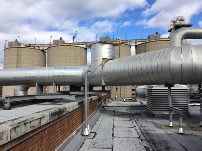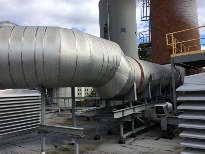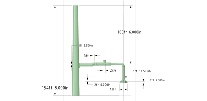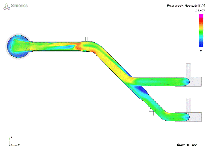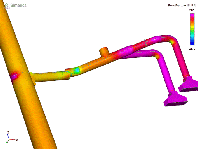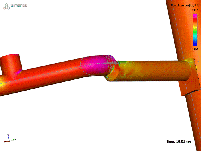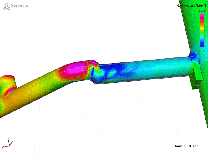


Phone: +44 (0) 1494 616020
Discovery SpaceClaim®
Discovery Live®

UpFront Engineering Simulation
© 2011-2019 80/20 Engineering Ltd. All other copyrights on this site are the properties of their owners
...A division of

University of Virginia – Energy and Utilities
www.fm.virginia.edu/depts/operations/energyutilities.html
The University of Virginia at Charlottesville has over 16 million GSF on 1175 acres. The University is built on a district energy model, with three heat plants, eleven chiller plants, hundreds of miles of (steam, hot water, chilled water, potable water, sanitary, and storm water) distribution, and an internal medium voltage electrical distribution grid anchored by three 34kV to 13kV substations.
The Main Heat Plant at UVa generates steam and superheated water which is distributed through a network of underground piping to most facilities on the grounds. The Chiller Plants provide year-round chilled water services for air conditioning and process applications to more than 10 million square feet. The Power and Light team maintains three electrical substations and associated underground distribution lines. The Utilities team maintains more than 150 miles of underground systems including heating (steam/condensate, medium temperature hot water), cooling (chilled water), potable water, sanitary sewer and storm water drains.
Jacobs Engineering (http://www.jacobs.com) are contracted to develop options and recommendations regarding the future expansion of UVa’s Energy and Utilities plants and equipment.
…In order to help diagnose the cause of two of the Heat Plant Boilers running significantly below rated capacity, UVa’s Energy and Utilities team, with Jacobs Engineering, commissioned 80/20 Software to provide consultancy assistance to their own ongoing engineering activity. Below is a brief summary of a CFD study carried out with the objective of understanding the flow and pressure distribution through the Boiler Plant’s Breeching System.
UVa Energy and Utilities - Case Study Work
(Only some of the case study results shown opposite)
Above approximately 88% of the maximum output from the Boilers, the control instrumentation started to show certain unusual and erratic behavior that caused concern and hindered running at the full capacity load. CFD simulation techniques were able to help the Plant Engineers in providing insights into the flow patterns and pressure fluctuations that were difficult to obtain otherwise, particularly the fluctuation magnitudes.
‘The CFD results gave my team the confidence in the Plant’s Breeching system existing layout so as to push through the observed control instrumentation instabilities’ says Paul Zmick, Senior Associate Director, Energy and Utilities. ‘The additional 20,000 pph steam output that we are now achieving is the equivalent of $2 million in new boiler capacity’
Managing the fluid flow path’s behavior within a Plant Breeching system efficiently can substantially reduce the pressure drop and eliminate the formation of flow instabilities and/or re-circulation zones. Using CFD simulation, a complete three-dimensional pressure map can be obtained at any operating condition or environment. Once a design concept is selected a series of ’virtual tests’ can be carried out to refine the idea or evaluate the impact of any installation, assembly or material specification constraints.
CFD simulation is routinely used within product development for flow performance prediction to dramatically reduce the number of physical prototypes and test work required which will either reduce product development lead times, cost to the client or enhance the quality of the product received by the client.
Within the Facilities Management sector generally, building prototypes is often just not possible. UVa’s Energy and Utility demands will continue to grow as the University continues to expand, and shown above is the potential for CFD techniques to maximize a plant’s overall capacity, avoiding or delaying significant capital investment.
UVA’s Energy and Utilities team is responsible for energy procurement, generation, distribution, and operation, maintenance, and renewal of the utilities infrastructure, with a strategic focus on safety, sustainability, and stewardship. This team has primary responsibility to insure both present and future energy needs of the University Community are realized through the most reliable, resilient, sustainable and cost effective plan. Minimizing fossil fuel consumption and integrating new and alternative energy generation and distribution technology with the existing infrastructure are strategic elements of this plan.
About 80/20 Software, a US subsidiary of 80/20 Engineering, is a specialist Fluid Flow Simulation and Thermal Analysis Consultancy Company. We have a long track record of helping companies implement ‘Design Friendly’ or ‘UpFront CFD’ user environments that we believe will play an ever-increasing role within product development and process design. However, often the client project demands are such that there is an urgent need for a design to be improved or a problem resolved. In these situations, we have a team of experienced simulation engineers to call upon.

‘Snapshot of Oscillating Flow patterns’
‘Actual Segments of Plant Breeching System’
‘2D Cross Section Velocity (z)’
‘3D Model Construction’
‘Pressure Contours on
inside walls’
‘Close-up of Step Down Region’
